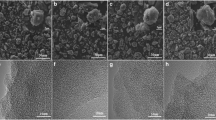Abstract
The electrochemical performances of an electrical double layer capacitor were investigated regarding the activated carbon prepared from bamboo by a new approach, that is, the combination of delignification, addition of guanidine phosphate, and CO2 activation. In this study, a 1 M H2SO4 aqueous solution was used as the electrolyte of the capacitor. The physical properties, such as the BET specific surface area of the carbon material, depend on the preparation conditions of the activated carbon. A TEM image indicated that the addition of guanidine phosphate did not facilitate the graphitization and did not prevent activation by CO2. The apparent reaction equation for the CO2 activation was first-order, which is reasonable for physical activation. The electrochemical performances of the carbon material depended on the preparation conditions of the carbon material, such as the heat treatment temperature, amount of added guanidine phosphate, and CO2 activation time. The sample prepared under the following conditions (the amount of added guanidine phosphate: 9 wt%, the heat treatment temperature: 800 °C, CO2 activation time: 3 h) had the highest performance (153 F g−1 at 1000 mA g−1) because the sample had the highest BET specific surface area (2001 m2 g−1).









Similar content being viewed by others
References
D.A. Gonzalez, E. Goikolea, J.A. Barrena, R. Mysyk, Review on supercapacitors: technologies and materials. Renew. Sustain. Energy Rev. 58, 1189–1206 (2016)
A.C. Forse, C. Merlet, J.M. Griffin, C.P. Grey, New perspectives on the charging mechanisms of supercapacitors. J. Am. Chem. Soc. 138, 5731–5744 (2016)
A.G. Pandolfo, A.F. Hollenkamp, Carbon properties and their role in supercapacitors. J. Power Sources 157, 11–27 (2006)
M.A. Lillo-Rodenas, D. Cazorla-Amoros, A. Linares-Solano, Understanding chemical reactions between carbons and NaOH and KOH an insight into the chemical activation mechanism. Carbon 41, 267–275 (2003)
O. Ioannidou, A. Zabaniotou, Agricultural residues as precursors for activated carbon production-A review. Renew. Sustain. Energy Rev. 11, 1966–2005 (2007)
A.R. Mohamed, M. Mohammadi, G.N. Darzi, Preparation of carbon molecular sieve from lignocellulosic biomass: A review. Renew. Sustain. Energy Rev. 14, 1591–1599 (2010)
P. Kalyani, A. Anitha, Biomass carbon & its prospects in electrochemical energy systems. Int. J. Hydrog. Energy 38, 4034–4045 (2013)
Y.X. Wang, H.H. Ngo, W.S. Guo, Preparation of specific bamboo based activated carbon and its application for ciprofloxacin removal. Sci. Total Environ. 533, 32–39 (2015)
Y.-P. Huang, C.-H. Hou, H.-C. His, J.-W. Wu, Optimization of highly microporous activated carbon preparation from Moso bamboo using central composite design approach. J. Taiwan Inst. Chem. Eng. 50, 266–275 (2015)
Y.J. Kim, B.J. Lee, H. Suezaki, T. Chino, Y. Abe, T. Yanagiura, K.C. Park, M. Endo, Preparation and characterization of bamboo-based activated carbons as electrode materials for electric double layer capacitors. Carbon 44, 1581–1616 (2006)
T. Tsubota, M. Morita, S. Kamimura, T. Ohno, New approach for synthesis of activated carbon from bamboo. J. Porous. Mater. 23, 349–355 (2016)
H. Itoi, H. Nishihara, T. Ishii, K. Nueangnoraj, R. Berenguer-Betrian, T. Kyotani, Large pseudocapacitance in quinone-functionalized zeorite-templated carbon. Bull. Chem. Soc. Jpn. 87, 250–257 (2014)
J. Chimola, G. Yushin, Y. Gogotsi, C. Portet, P. Simon, P.L. Taberna, Anomalous increase in carbon capacitance at pore sizes less than 1 nanometer. Science 313, 1760–1763 (2006)
Acknowledgements
The dried bamboo powder used in this study was provided by Bamboo Chemical Laboratory Co., Ltd. The authors express our thanks to Masayuki Tsuruha, a representative of the Bamboo Chemical Laboratory Co., Ltd. This study was supported by JSPS KAKENHI Grant Number 26410253 and the Yamagin Regional Enterprise Support Foundation.
Author information
Authors and Affiliations
Corresponding author
Rights and permissions
About this article
Cite this article
Tsubota, T., Morita, M., Kamimura, S. et al. Performance as electrode of electrical double layer capacitor of activated carbon prepared from bamboo using guanidine phosphate and CO2 activation. J Porous Mater 24, 1507–1512 (2017). https://doi.org/10.1007/s10934-017-0390-5
Published:
Issue Date:
DOI: https://doi.org/10.1007/s10934-017-0390-5




